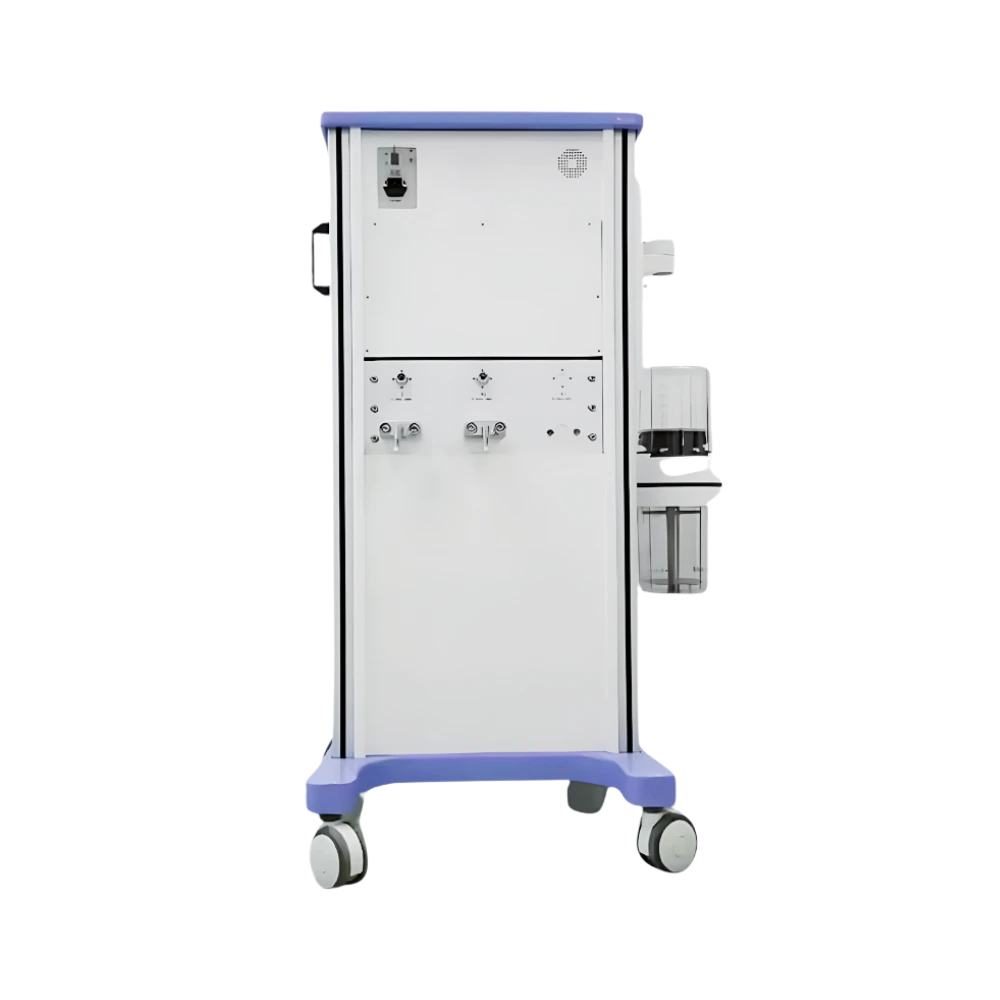


Anesthesia System MD-ANS-1001 provides a Positive End Expiratory Pressure range of 0 to 30 cmH2O. It provides a versatile ventilation parameter range of tidal volumes from 20 mL to 1500 mL. This advanced system offers a variety of ventilation modes and adjustable parameters. It also provides a wide frequency range ensuring precise control and customized care to meet the needs of each patient. Our anesthesia system is a highly efficient and adaptable solution ideal for anesthesia and critical care settings.
$ 6075 : Each of 1
Specifications
| Ventilation Modes | IPPV, A/C, SIMV, SIGH, MANUAL |
| Gas Source | O2, N2O, AIR |
| Flowmeter range | O2: 0.1 to 10 L/min; N2O: 0.1 to 10 L/min AIR: 0.1 to 10L/min |
| Rapid Oxygen Supply Range | 25 L/min to 75 L/min |
| Oxygen Concentration | 15 % to 100 % |
| Tidal Volume (Vt) range | 0, 20 mL to 1500 mL |
| Frequency range | 1 /min to 100 /min |
| Inspiratory Ratio (I.E) | 2:1 - 1:6 |
| Minute Volume (MV) | 0 L/min to 100 L/min |
| Positive End-Expiratory Pressure (PEEP) | 0 cmH2O to 30 cmH2O |
| Pressure Triggering Sensitivity (PTr) | -20 cmH2O to 20 cmH2O (Based on PEEP) |
| Flow Trigger Sensitivity (FTr) | 0.5 L/min to 30 L/min |
| SIGH | 0 (off) 1/100 to 5/100 |
| Apnea Ventilation | OFF, 5 s to 60 s |
| Gas Pressure Range | 280 kPa to 600 kPa |
| Pressure Limit | 20 cmH2O to 100 cmH2O |
| Bellow | 1.5L |
| Oscillogram Types | P-T (Pressure-Time), F-T (Flow-Time), P-V loop (Pressure-Volume Loop) |
| The AC power failure alarm | Power failure or no connection |
| Alarm for backup battery | < 11.3 ± 0.3 V |
| No tidal volume | ≤ 5 mL within 6 s |
| High oxygen concentration alarm | 19% to 100% |
| Low oxygen concentration alarm | 18% to 99% |
| High airway pressure alarm | 20 cmH2O to 100 cmH2O |
| Low airway pressure alarm | 0 cmH2O to 20 cmH2O |
| High-minute volume alarm | Adult (5 L/min - 20 L/min) |
| Low-minute volume alarm | Paed (1 L/min - 15 L/min, 0 - 10 L/min) |
| Continuous pressure alarm | (PEEP+1.5 kPa) over 16s |
| Suffocation warning | 5 s – 60 s no spontaneous ventilation |
| The maximum limited pressure | < 12.5 kPa |
| Fan error | Shows on screen |
| Oxygen deficit | Shows on screen |
| Display | 7-inch LED screen |
| Power Consumption | 40 VA |
| Power Supply | Voltage: 100 to 240 V Power Frequency: 50/60 Hz |
| Packing Dimension | 760 × 970 × 1550 mm |
| Net Weight | 82.5 kg |
| Gross Weight | 143 kg |
Features
Oxygen sensor
Versatile Ventilation Modes
7-inch LED display
ACGO and Fast Oxygen supply
Precise Control of Respiratory Parameters
Advanced Alarm System
Comprehensive Monitoring
Oscillogram Display
Built-in backup battery
2-3 hours backup battery
Emergency and revival after operation
Compact and Durable Design
Standard Accessories
Anesthetic breathing system × 1
Power cord × 1
Fuse × 8
Fuse × 1
Fuse × 2
O2 cell × 1
CO2 sensor
Breathing tube × 2
Breathing tube × 2
Y connector Adult × 1
Y connector Child × 1
L connector × 2
Reservoir bag 1L × 1
Reservoir bag 3L × 1
Anesthetic mask adult × 1
Anesthetic mask infant × 1
Anesthesia Vaporizer × 2
High pressure O2 hose × 1
High-pressure AIR hose × 1
High pressure N2O hose × 1
Optional Accessories
Mainstream CO2 Sensor × 1
Sidestream CO2 Module × 1
Mainstream gas Analyzers × 1
Sidestream gas Analyzers × 1
CO2 Mainstream Module × 1
CO2 Sidestream Module × 1
Multi-gas Sensor × 1
Transfer and receiving system of exhaust gas × 1
Applications
Anesthesia System MD-ANS-1001 is ideal for patients who require ventilatory support, including those experiencing respiratory failure, trauma, or undergoing emergency surgeries.
Anesthesia System is an advanced, user-friendly anesthesia delivery system designed to meet the needs of modern healthcare facilities. Engineered for safety, accuracy, and efficiency, it features an intuitive touchscreen interface. It allows seamless control and monitoring of anesthesia parameters. With precise gas flow meters and integrated safety alarms, the system ensures optimal delivery of anesthetic gases while prioritizing patient safety. Built with adaptability in mind, Our system provides Precision Care system support for a range of patient types, from pediatric to adult.
$ 11100
$ 9250
$ 13848
$ 11540
$ 18720
$ 15600
$ 15912
$ 13260
$ 8100
$ 6750
$ 8748
$ 7290
$ 6804
$ 5670